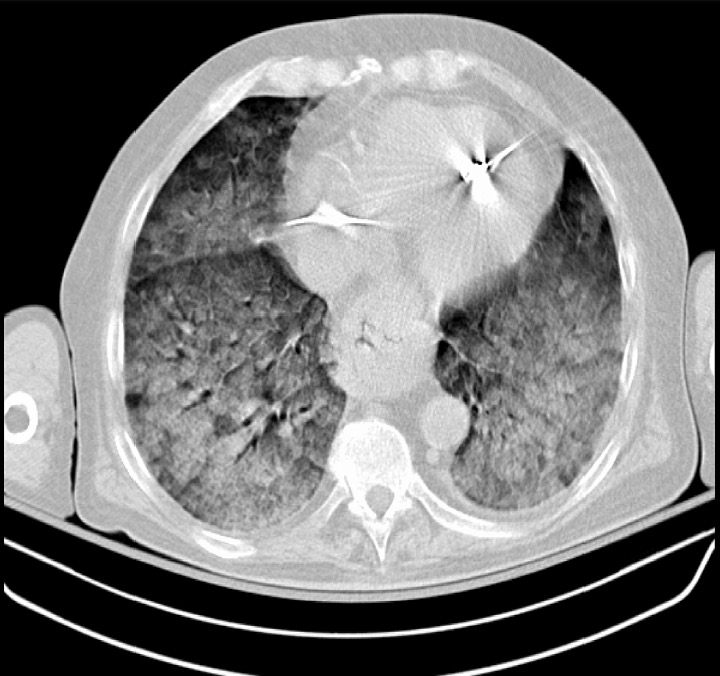Playlist
Show Playlist
Hide Playlist
Acute Respiratory Distress Syndrome (ARDS): Differential Diagnosis
-
Slides ARDS RespiratoryPathology.pdf
-
Reference List Pathology.pdf
-
Download Lecture Overview
00:01 Let’s take a look at important differential diagnosis for you in ARDS. Pulmonary edema. 00:06 ARDS should have a low pulmonary capillary wedge pressure. Can be challenging. Both sepsis with ARDS and low output congestive heart failure will have hypotension and bilateral pulmonary infiltrate. 00:21 What does that mean? It means that if you had sepsis by itself. Listen, it's a neurogenic or septic type of shock, right? So this would then mean that your blood vessels are severely vasodilated or vasoconstricted? Vasodilated severely. That gram negative organism, lipopolysaccharide causing massive vasodilation. If you have massive vasodilation universally, arterial side, through the capillaries, through the veins, you are not able to properly supply oxygen to your tissue. Hence, shock. We had this discussion during our shock type of lecture. 01:07 But, anyhow. So, now, you have sepsis by itself then you would have increased cardiac output because of decreased afterload. But, then if you have sepsis causing ARDS, which is quite common, then you are going to have low output. And you have hypertension. Low output congestive heart failure will have hypertension, both of these will. Next, ARDS. Both areas of the lungs, the alveolar has collapsed, therefore, you will have bilateral pulmonary infiltrate. If you have congestive heart failure, what are you going to find? Pulmonary edema. 01:43 Back up. That is cardiogenic, transudates, but obviously, this is bilateral type of pulmonary infiltrate. 01:51 Next, pneumonia a differential. The grey area as pneumonia can be caused of ARDS, be careful. And then neonate. Respiratory distress of a newborn but this would be due to surfactant deficiency as we shall see. Some important differentials here. Be able to go through the first two bullet points. Pulmonary edema, but ARDS will have a lower to normal pulmonary capillary wedge pressure clinically. Is that clear? Whereas pulmonary edema, if it was by itself without ARDS, will have an increase in pulmonary capillary wedge pressure. 02:27 And the other big one here was the low cardiac output that we saw with ARDS in the setting of sepsis and cardiogenic issues.
About the Lecture
The lecture Acute Respiratory Distress Syndrome (ARDS): Differential Diagnosis by Carlo Raj, MD is from the course Disorders of the Pulmonary Circulation and the Respiratory Regulation.
Included Quiz Questions
Which of the following parameters is essential to distinguish cardiogenic pulmonary edema from acute respiratory distress syndrome?
- Increased pulmonary capillary wedge pressure
- Decreased pulmonary capillary wedge pressure
- Normal pulmonary capillary wedge pressure
- Decreased blood pressure
- Bilateral pulmonary infiltrates
Which of the following statements is correct?
- Exudate and low PCWP are seen in ARDS
- Transudate and low PCWP are seen in ARDS
- Exudate and high PCWP are seen in ARDS
- Exudate and low PCWP are seen in low-output CHF
- Transudate and low PCWP are seen in low-output CHF
Customer reviews
5,0 of 5 stars
| 5 Stars |
|
1 |
| 4 Stars |
|
0 |
| 3 Stars |
|
0 |
| 2 Stars |
|
0 |
| 1 Star |
|
0 |
Once again, Dr. Raj is blowing my mind with the way he teach medicine. Connecting everything from here on out to eternity. I have a question about that second quiz question about sepsis before ARDS. The answer was that ARDS following sepsis will decrease the cardiac output, and that was according to what Dr. Raj said in the lectures. Is it possible that we could also have a situation with respiratory rate increasing?




